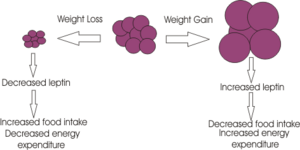Leptin
((subpages}}
A major breakthrough in the study of appetite regulation came in 1994 when the molecular geneticist Jeffrey Friedman discovered the adiposity signal leptin. By studies of an inbred line of obese mice, the ob/ob mice which were thought to lack a satiety signal, Friedman and colleagues found that 'ob' codes for a gene that coded for a novel peptide hormone, which they called leptin, from the Greek ‘leptos’ meaning thin. Mice deficient in this gene are morbidly obese and this obesity can be reversed by giving the mice leptin.
The leptin receptor was found in 1995 and is a member of the cytokine receptor family.[1]
Leptin is a signalling molecule secreted from adipocyte cells into the blood, and the plasma concentration of leptin is thus proportional to the total body fat mass. Leptin is transported into the brain from the blood, where it suppresses apetite by its effects on specific neurones in the brain that express leptin receptors; in particular on neurones of the arcuate nucleus and ventromedial nucleus of the hypothalamus.[2] Leptin receptor mRNA is found primarily in the hypothalamic arcuate nucleus, ventromedial nuclei and dorsomedial hypothalamic nuclei, regions that are known to be involved in appetite control.
Unsurprisingly there was huge media interest in leptin as a possible treatment for obesity, and the biotechnology company Amgen paid $20 million to license leptin. However the results of clinical trials on obese people were disappointing. Most people are not obese because of a deficiency in leptin, but are just unable to respond to it; they had more fat cells and so more circulating leptin and as a result, reduced sensitivity of the leptin receptor. However, about 30% of the subjects lost weight and so may have low circulating levels of leptin. Potentially these might benefit from leptin therapy. The task now though is to identify people with an abnormally low circulating level of leptin.
The use of leptin as a drug has proved valuable in the disease lipodystrophy and in rare cases of people who have a defective leptin gene and so are constantly hungry.
The weight loss caused by leptin seems to arise because of two effects;
1. Inhibiting appetite through its actions on the appetite-stimulating neuropeptide Y neurones and the appetite-inhibiting proopiomelanocortin (POMC) neurons, located in the hypothalamic arcuate nucleus. Leptin inhibits the NPY neurons,causing a decrease in the release of the inhibitory neurotransmitter GABA (which is synthesised by the NPY neurons). This "disinhibits" the POMC neurons which increase their firing rate leading to the release of alpha MSH – a product of POMC which is a potent inhibitor of appetite. Leptin also acts directly on the POMC neurons.
2. Leptin also increases energy expenditure by increasing body temperature and oxygen consumption
As yet it is still unknown how exactly leptin exerts its inhibitory effects on feeding behaviour. It acts on the JAK/STAT pathway, effecting gene transcription and other cellular signalling pathways but a definitive mode of action has not been found; leptin's mode of action probably involves several different signalling pathways.
Leptin is synthesised in many other tissues including the stomach, ovary, placenta and liver and its receptors are also located in a diverse range of tissues. It plays a role in many other physiological functions such as reproduction, where levels of leptin appear to dictate the commencement of menstruation and in foetal development where there is a surge in leptin levels in the first week of life, which does not correspond to a decrease in food intake but is thought to be a developmental signal. During development, mice deficient in leptin have disruptions in the arcuate nucleus neural projections, but not other hypothalamic projections, and these effects can be reversed upon leptin treatment.
Leptin’s main function is still under consideration as it also plays a role in many other physiological processes. For example it can be thought of as a signal informing the body when it has sufficient fat to accommodate an ‘expensive’ physiological function like reproduction. Leptin therefore appears to protect the body against starvation by only allowing energy dense processes to occur when the body is sufficiently ready. Its primary role is complex, is it a satiety signal to prevent overeating or an evolutionarily efficient signal protecting against starvation?
- ↑ Zhang et al. (1994) Positional cloning of the mouse obese gene and its human homologue. Nature 372:425-32 - these authors first identified leptin
- ↑ Schwartz et al. (2000) Central nervous system control of food intake. Nature 404:661-71 - detailing the effects of leptin on molecular pathways in the brain.
